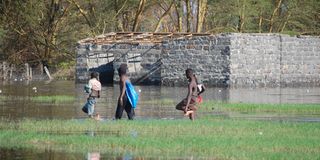Task force on rising lake urges payouts for affected households

Barut residents walk past a submerged house due to the rising water levels at Lake Nakuru.
A task force appointed by outgoing Nakuru Governor Lee Kinyanjui to look into rising water levels at Lake Nakuru has recommended that the government consider compensating and buying out affected households in flood-prone areas.
The team, led by Water, Environment and Natural Resources executive Festus Ng'eno, said perennial flooding that began in early 2011 had displaced thousands, destroyed property and made the land unsuitable for farming and living on due to salty lake water.
“The government should consider purchasing the land and relocating the people who live around the lake who have been bearing the brunt of the rising waters of the lake. The land around the lake is no longer inhabitable,” said Mr Ng’eno.
“The county government of Nakuru jointly worked with the national government on a more comprehensive field ground-trothing coupled with satellite image field validation to acquire requisite spatial data for alerts and possible mitigation and adaptation planning.”
Mr Jackson Raini, an environmental expert and member of the task force, cited seismic and other underground movements, a frequent occurrence in the Rift Valley, as the cause of rising water levels in the lake.
"The tectonics create a near field (a localised area affected by earth's activities) and a far field (an earth area that is far away) compressional and tensional stress fields,” he said.
“The near field stress regime or earth area will respond to the far field stress regime, but with a time lag. In our case, the near field is the Rift Valley responding to the pull of the Indian Ocean, which is a far-field body."
Scientists attribute the rising water levels in the lake to the effects of regional tectonics influenced by the movements of the earth's plate tectonics.
Other reasons advanced by the experts for the rising water levels are seasonal rainfall and evaporation, which have intensified land degradation, resulting in higher run-off and leading to larger volumes of water flowing directly into the lake.
Mr Raini said climate change has for over a decade led to high rainfall in the region, causing ground over-saturation, as demonstrated by rising water in boreholes in other parts of Nakuru County.
Mr Kiogora Muriithi, the Water, Environment, Energy and Natural Resources chief officer, also noted that the government should map affected riparian land for conservation.
Mr John Endebe, a task force member representing the Kenya Wildlife Service, said flooding affected Lake Nakuru National Park biodiversity, such as the drying up of acacia trees that giraffes feed on.
He said the flooding raised human-wildlife conflict as animals fled flooded sections to farmlands after power to the electric fence surrounding the world-renowned park was switched off.
Rising water levels in Lake Nakuru in 2020 displaced hundreds of households.
Vegetation was submerged as the water swallowed up several establishments in the neighbourhood, among them homesteads and farms in Barut and Lake View areas.
Lake Nakuru, traditionally a flamingo sanctuary, also saw thousands of the birds flee to other areas.
Hundreds of animals were also displaced from Lake Nakuru National Park as lake waters rose.
Lake waters submerged parts of the park, flooding hundreds of acres that provided food and home to wildlife, and squeezed the animals into rapidly decreasing space.
Environment experts said water levels in the lake have been rising steadily since around 2011.
Lake Nakuru National Park is a sanctuary for a variety of wildlife, including Rothschild giraffes, buffaloes and black rhinos.





